The chronology
that follows covers the final ten years of John Cassavetes' life and
the nineteen years following his death. To access a chronology and
list of events covering the first forty years of Cassavetes' life, from
1929 through 1968, click
here.
To read more
about many of the events described below, go to the "About Ray
Carney" and the "Ray Carney's Discoveries" sections of
the site (in the left menu on this page) and the associated links. All
of the books and articles by Prof. Carney that are mentioned can be
purchased via the "Bookstore" link (also in the left menu
on this page).
1979-1990
/ 1990-1995
/ 1996-2000
/ 2001-2005
/ 2006-2007
1
<
Page 2 <
3
Click
here for best printing of text
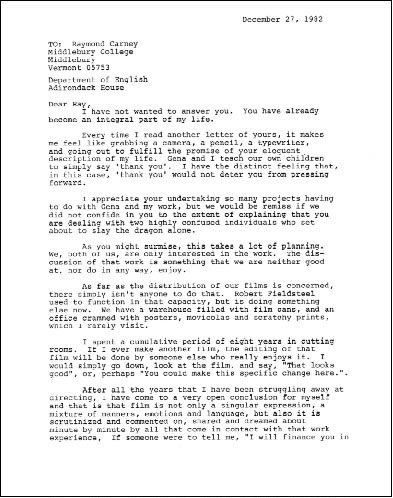 1990
1990
A Woman Under the Influence
is added to the National Film Registry by the Film Preservation Board
established by the Library of Congress to preserve film deemed "culturally,
historically, or esthetically important."
1991
May 12: Lisa Katzman publishes an article in the New York Times
that says that Cassavetes was "demoralized" by the failure of Opening
Night and pulled it 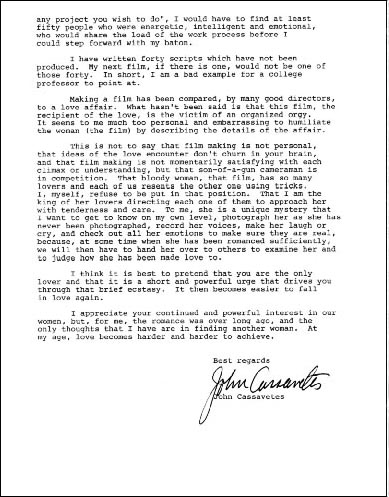 from
circulation in an effort to "cut his emotional losses." Gena Rowlands sees a pre - publication copy of
the interview and has Al Ruban call Ray Carney and ask the source of this information.
When Carney says that it is a paraphrase of an interview
Katzman conducted with him and accurately
reflects a statement Cassavetes made to Carney, Ruban
tells him that Rowlands is extremely upset by the comment and insists
that Carney call the writer and demand that the objectionable sentences
be removed from the article before it is published. Carney tells Ruban
he will not do that.
from
circulation in an effort to "cut his emotional losses." Gena Rowlands sees a pre - publication copy of
the interview and has Al Ruban call Ray Carney and ask the source of this information.
When Carney says that it is a paraphrase of an interview
Katzman conducted with him and accurately
reflects a statement Cassavetes made to Carney, Ruban
tells him that Rowlands is extremely upset by the comment and insists
that Carney call the writer and demand that the objectionable sentences
be removed from the article before it is published. Carney tells Ruban
he will not do that.
In response to Carney's
comments to Katzman (as well as subsequent
statements by Carney that Rowlands does not approve of) Rowlands and
Ruban take three courses of action. The first
is that, without explicitly naming Carney as the target of her remarks,
Rowlands makes it a point to rebut Carney's statements in future interviews.
To rebut the Katzman observation, interviewers are told, even when they haven't asked about it, that her husband was never depressed, discouraged, or sad. A sample quote from a 2002 Rowlands interview with Matthew Hays for the Montreal Mirror: "I know there are certain people, especially one professor in particular, who think that John was unhappy with reactions to his work. But I don't think John cared. I never saw John depressed."
The second response
is that Rowlands, through Ruban, attempts to blackball Carney from attending festivals
screening Cassavetes' works. Film festivals conducting retrospectives
in Spain, Portugal, Greece, and Japan, and elsewhere are
told to withdraw invitations for Carney to attend and/or to cancel events
he has organized or Cassavetes' films will not be provided for their
use.
The third
response is to vilify Carney to film curators and programmers and to
denigrate his work at public events. Click
here to read more about the attacks conducted by business manager
Ruban with Rowlands's knowledge and permission.
Mid - 1991 to mid - 1992
Ray Carney guest-edits the "John Cassavetes Special
Issue" published by Post-Script: Essays in Film and the Humanities
as their Winter 1992 issue. When a year - long
call for papers attracts only three brief submissions (an interview
by Maria Viera, an essay by Carole Zucker, and an essay co - written by Janice Zwierzynski and George Kouvarous)
to avoid having the issue cancelled, Carney commissions a fourth article
from one of his students, Lucio Benedetto,
and writes 77 of the issue's 112 pages himself.
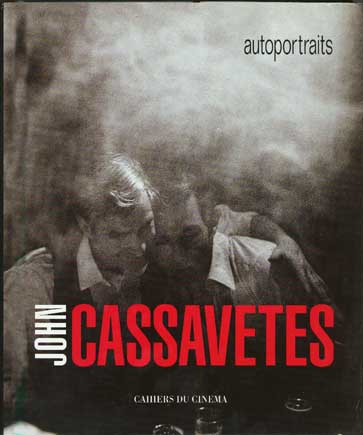 1992
1992
February: Ray
Carney publishes a coffee table picture - book devoted
to Cassavetes' life and work: John Cassavetes - Autoportraits,
published by Editions de l'Etoile/Cahiers
du cinema. It is introduced by Andre Labarthe
and translated into French by Serge Grunberg.
It becomes the best selling book in any language about Cassavetes. As
a condition of giving permission for publication, Gena
Rowlands insists on structuring the publishing contract so that royalty
payments are made not to Carney but to her.
1992 - 1993
Going for the most
lucrative financial offer, Gena Rowlands sells
Touchstone, a division of the Disney Corporation, exclusive video rights
to "the Cassavetes collection." The films to be issued are: the second
version of Shadows, Faces, A Woman Under the Influence, the second version of The Killing of a Chinese Bookie,
and Opening Night, none of which has appeared on video before.
Touchstone is ill - suited to appreciate or release Cassavetes' work.
After issuing two of the five titles, it abandons the project and sells
off its interest in all five titles. For more information, click
here.
1993
The second version
of Shadows is added to the National Film Registry by the Film
Preservation Board established by the Library of Congress to preserve
film deemed "culturally, historically, or esthetically important."
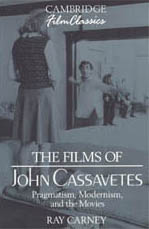 1994
1994
April 10: Ray Carney's The
Films of John Cassavetes: Pragmatism, Modernism, and the Movies is published by Cambridge University Press. It is illustrated
with 50 behind - the - scenes photographs by Sam Shaw. Ruban attempts to stop the book from being published.
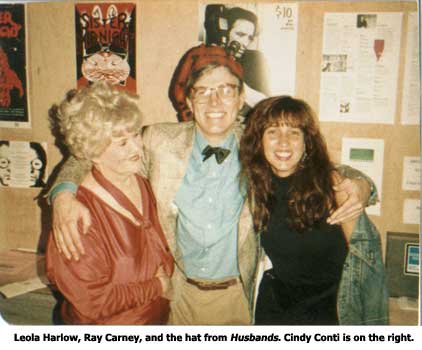 April 28: The UCLA Dept. of Preservation screens
a so - called "restored" print of Husbands during their "6th Festival
of Preservation." During the restoration process Gena
Rowlands tells the Archive that she thinks the singing scene with Leola
Harlow is offensive and goes on too long and that the vomiting part
of the men's room scene is in bad taste. In an effort to please her,
material is left out of the print. All subsequent prints and videos
also omit this material. (Click here to hear the audio of twelve minutes that were cut at the end of the singing scene and the beginning of the men's room scene in Husbands.)
April 28: The UCLA Dept. of Preservation screens
a so - called "restored" print of Husbands during their "6th Festival
of Preservation." During the restoration process Gena
Rowlands tells the Archive that she thinks the singing scene with Leola
Harlow is offensive and goes on too long and that the vomiting part
of the men's room scene is in bad taste. In an effort to please her,
material is left out of the print. All subsequent prints and videos
also omit this material. (Click here to hear the audio of twelve minutes that were cut at the end of the singing scene and the beginning of the men's room scene in Husbands.)
May: As part of the first "Beat Festival" at New York
University, Ray Carney
programs Shadows as a key beat work. The film has never before
been included in a survey of beat film or treated as being related to
the beat movement. Carney hosts a reunion of the cast and crew of Shadows,
featuring Lelia Goldoni,
Hugh Hurd, Maurice McEndree,
George O'Halloran, Jonas Mekas,
and others, focusing on Cassavetes' creative methods and the relation
of the first and second versions of the film.
1995
Nicole
Brenez's French - language Shadows: John
Cassavetes is published by Editions Nathan in Paris. It is riddled with dozens of factual
and interpretive errors, many due to Brenez's imperfect grasp of English.
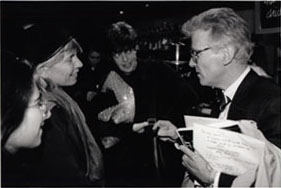 Ray
Carney informs Al Ruban about the search for the first version of Shadows
and is told that "there is no such print," and that even if
it were found, Ruban "will make sure it is never seen." Ruban,
who had only the most tangential involvement with the second version
and no involvement with or knowledge of the filming or screening of
the first version, ominously insists: "There is only one version
of Shadows" -- presumably because it would cut into rentals
of the available version, which he controls.
Ray
Carney informs Al Ruban about the search for the first version of Shadows
and is told that "there is no such print," and that even if
it were found, Ruban "will make sure it is never seen." Ruban,
who had only the most tangential involvement with the second version
and no involvement with or knowledge of the filming or screening of
the first version, ominously insists: "There is only one version
of Shadows" -- presumably because it would cut into rentals
of the available version, which he controls.
Ray Carney co - curates the "Beat Culture and the New America, 1950 - 1965" show for the Whitney
Museum of American Art, and programs Shadows as one
of the seminal, defining works of the period. He contributes two essays
to the catalogue, one comparing Shadows and Pull My Daisy
and the other placing Cassavetes' achievement within the context of
the Beat movement. The show opens in New
York in 1995 and travels to Minneapolis and San Francisco in 1996 to great critical acclaim.
1
<
Page 2 <
3
1979-1990
/ 1990-1995
/ 1996-2000
/ 2001-2005
/ 2006-2007
The chronology
above covers the final ten years of John Cassavetes' life and the nineteen years following his death. To access a chronology and list of events
covering the first forty years of Cassavetes' life, from 1929 through
1968, click
here.
To read more
about many of the events described above, go to the "About Ray
Carney" and the "Ray Carney's Discoveries" sections of
the site (in the left menu on this page) and the associated links. All
of the books and articles by Prof. Carney that are mentioned can be
purchased via the "Bookstore" link (also in the left menu
on this page).










